112. Livingston Ripley Waterfowl Conservancy
Duck, Duck, Emperor Goose
Litchfield (Google Maps Location)
June 7, 2009
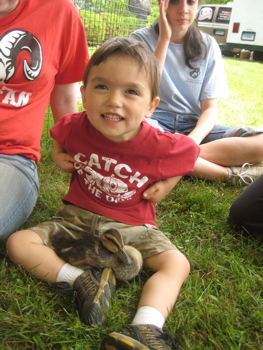 People always ask me how I find stuff for my museum list. Short answer: Every which way you can imagine – and then some. Well over three years into this thing now, I’m finding out about new places still on a fairly frequent basis. I’d never heard of the Livingston Ripley Waterfowl Conservancy at all until I saw piece on it on Diane Smith’s “All Things Connecticut” on our local PBS channel.
People always ask me how I find stuff for my museum list. Short answer: Every which way you can imagine – and then some. Well over three years into this thing now, I’m finding out about new places still on a fairly frequent basis. I’d never heard of the Livingston Ripley Waterfowl Conservancy at all until I saw piece on it on Diane Smith’s “All Things Connecticut” on our local PBS channel.
You can watch the piece yourself. I wasn’t sure if it was a museum exactly, but after looking it up online and learning about its once per annum Duck Day, I made plans and figured I’d check it out for myself.
And no, this page is not just an excuse to bludgeon you with Damian, duck, and Damian with duck cuteness. It just appears that way.
Located in the far reaches of Litchfield, the Livingston Ripley Waterfowl Conservancy (LRWC) is dedicated to the protection of waterfowl and wetland habits through research, education and conservation action. The LRWC is one of the largest  not-for-profit breeding facilities for waterfowl in North America. Home to over 60 species of waterfowl from throughout the world, the LRWC maintains a diverse collection of waterfowl with an active propagation program that provides birds to reintroduction programs, zoos and educational programs. Founded by S. Dillon Ripley in 1985, the history of the LRWC is deeply rooted in his dedicated to the preservation and conservation of rare, threatened and endangered species.
not-for-profit breeding facilities for waterfowl in North America. Home to over 60 species of waterfowl from throughout the world, the LRWC maintains a diverse collection of waterfowl with an active propagation program that provides birds to reintroduction programs, zoos and educational programs. Founded by S. Dillon Ripley in 1985, the history of the LRWC is deeply rooted in his dedicated to the preservation and conservation of rare, threatened and endangered species.
Today, the LRWC also recognizes the importance of a strong focus on the restoration and conservation of wetland habitats worldwide. Integration of an active research program, with conservation actions and a premier captive breeding facility, is an essential component of the LRWC program designed to make substantial contributions to the management of waterfowl. Central to the mission of the LRWC, along with research and conservation action, is education. The LRWC maintains an active educational program, both on and off site, to promote public awareness of the continued need for the conservation of waterfowl and wetland habitats.
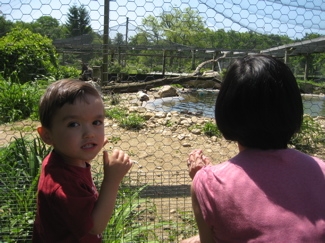 It sure sounds like a cool place – and as you can see from the pictures, it’s a great place to visit during Duck Day. They do offer $10 tours on Sundays at 2:00 P.M. during the months of May, June, September and October. And children under the age of 10 are free! Yet another great day trip that everyone will enjoy.
It sure sounds like a cool place – and as you can see from the pictures, it’s a great place to visit during Duck Day. They do offer $10 tours on Sundays at 2:00 P.M. during the months of May, June, September and October. And children under the age of 10 are free! Yet another great day trip that everyone will enjoy.
We stopped off at the Bantam Bread Company to score some dirt bombs before heading up to Duck Day. Man, are they ever delicious. Duck Day is quite popular, apparently, as we were forced to park in a field and hoof it to the property. They did have hayrides on offer, but we figured Damian wouldn’t enjoy that so much – and the walk wasn’t too far anyway. As Damian munched on his second dirt bomb, we learned about this namesakes of this unique place:
 Waterfowl were an early and enduring interest for S. Dillon Ripley, who spent weekends and summers in Litchfield, Connecticut, during childhood. He started his first duck pond at the age of 17 with the gift of a pair of blue-winged teal and a pair of redheads from his mother. Alain White, the naturalist who gave the 4,000 acre White Memorial Foundation to Litchfield, provided additional waterfowl for Dillon’s early collection. Dillon Ripley’s interest in birds grew over the years, and along with his collection of rare waterfowl. He named his network of ponds, pens and barns “Paddling Ponds,” and he expanded his interest into a lifetime devotion to the conservation of rare, threatened and endangered species of birds.
Waterfowl were an early and enduring interest for S. Dillon Ripley, who spent weekends and summers in Litchfield, Connecticut, during childhood. He started his first duck pond at the age of 17 with the gift of a pair of blue-winged teal and a pair of redheads from his mother. Alain White, the naturalist who gave the 4,000 acre White Memorial Foundation to Litchfield, provided additional waterfowl for Dillon’s early collection. Dillon Ripley’s interest in birds grew over the years, and along with his collection of rare waterfowl. He named his network of ponds, pens and barns “Paddling Ponds,” and he expanded his interest into a lifetime devotion to the conservation of rare, threatened and endangered species of birds.
Dillon Ripley became an ornithologist, a teacher, a historian, a researcher, and a world traveler. He was a professor at Yale University and the director of Yale’s Peabody Museum of Natural History. He was also the Secretary of the Smithsonian Institution for two decades and the author of numerous books and articles. His wife, Mary Livingston Ripley, who became a self-taught entomologist, shared his interests and together they traveled the world, finding and collecting rare and exotic species of birds and insects.
Dillon Ripley developed an impressive list of lifelong accomplishments; however, it was his passion for waterfowl that laid the groundwork for the LRWC. An avid aviculturist, Dillon Ripley is credited with being the first person to propagate successfully many threatened and endangered species in captivity, such as the red-breasted goose, nene goose, emperor goose and Laysan teal.
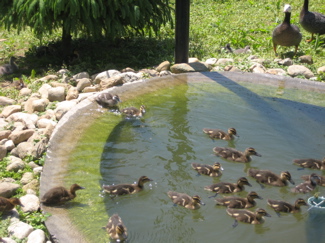 Dr. Ripley also raised various endangered species in Litchfield for re-introduction to the wild. One important example was during the late 1950s and early 1960s when the Ripleys were the only people in North America raising nene (Hawaiian) geese, which were threatened with extinction in the Hawaii. They sent a small flock of birds to Hawaii where, along with birds raised by Peter Scott’s Wildfowl and Wetlands Trust in England, they were released on the island of Maui. The reintroduction program was successful, and by the late1960s, the total population of nene geese increased to 500, up from only 50 birds fifteen years earlier.
Dr. Ripley also raised various endangered species in Litchfield for re-introduction to the wild. One important example was during the late 1950s and early 1960s when the Ripleys were the only people in North America raising nene (Hawaiian) geese, which were threatened with extinction in the Hawaii. They sent a small flock of birds to Hawaii where, along with birds raised by Peter Scott’s Wildfowl and Wetlands Trust in England, they were released on the island of Maui. The reintroduction program was successful, and by the late1960s, the total population of nene geese increased to 500, up from only 50 birds fifteen years earlier.
Today the LRWC is one of the preeminent facilities for breeding rare and endangered waterfowl, with an integrated program promoting research, education, and conservation action for waterfowl and wetland habitats. I love this stuff. And Duck Day is the day to go.
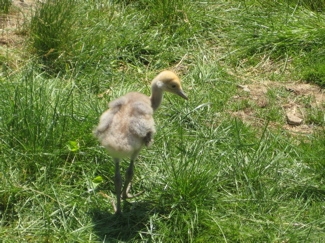 The Conservancy’s annual open house, Duck Day, is a family oriented event which includes an array of educational, entertaining, and memorable events. Established in 2006, Duck Day is an opportunity for visitors to learn about our research, conservation, and education programs. Throughout the day, the Conservancy’s rearing barn and several aviaries are open to attendees interested in learning about our captive waterfowl collection and breeding program. Participants can visit numerous booths and exhibits provided by wildlife and conservation organizations, artists, carvers, and photographers. Special event programs have included birds of prey demonstrations, exhibitions of canine retriever skills, puppet shows, and a rubber duck race fundraiser for outdoor-oriented prizes.
The Conservancy’s annual open house, Duck Day, is a family oriented event which includes an array of educational, entertaining, and memorable events. Established in 2006, Duck Day is an opportunity for visitors to learn about our research, conservation, and education programs. Throughout the day, the Conservancy’s rearing barn and several aviaries are open to attendees interested in learning about our captive waterfowl collection and breeding program. Participants can visit numerous booths and exhibits provided by wildlife and conservation organizations, artists, carvers, and photographers. Special event programs have included birds of prey demonstrations, exhibitions of canine retriever skills, puppet shows, and a rubber duck race fundraiser for outdoor-oriented prizes.
There was an entrance fee, but I forget what it was. (Which means it didn’t break the bank.) There are several large holding areas right as one enters the property containing all sorts of waterfowl I’d never heard of before. Not that I’m any sort of waterfowl expert, but they’ve got some doozies here. A Barnacle Goose from Europe? A Laysan Teal from Laysan Island, wherever that is? A Maned Duck from Australia? They even have Emperor Geese from Alaska and Siberia.
Hey, this is nice; the LRWC site has a little wrap-up of Duck Day 2009. I like to think they wrote this just for me:
 The sky was blue, the air was warm, and the LRWC’s fourth annual Duck Day experienced record attendance. Over 1,000 people attended the festivities. Special events included the always popular puppet show by renowned puppeteer Jim Napolitano and a live demonstration of canine retrieving ability conducted by Larry Hindman of the Maryland Department of Natural Resources. We had several new attractions this year, including an amazing display of swarming honey bees by Alphonse Avitabile, which was featured the next day on the front page of the local paper. The Audubon Sharon exhibit drew a standing-room-only crowd for Erin O’Connell’s program featuring Connecticut’s birds of prey. Our new waterfowl coloring booth was packed with kids, producing 150 crayon masterpieces which covered the tent wall by the end of the day.
The sky was blue, the air was warm, and the LRWC’s fourth annual Duck Day experienced record attendance. Over 1,000 people attended the festivities. Special events included the always popular puppet show by renowned puppeteer Jim Napolitano and a live demonstration of canine retrieving ability conducted by Larry Hindman of the Maryland Department of Natural Resources. We had several new attractions this year, including an amazing display of swarming honey bees by Alphonse Avitabile, which was featured the next day on the front page of the local paper. The Audubon Sharon exhibit drew a standing-room-only crowd for Erin O’Connell’s program featuring Connecticut’s birds of prey. Our new waterfowl coloring booth was packed with kids, producing 150 crayon masterpieces which covered the tent wall by the end of the day.
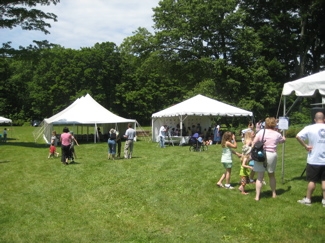 Duck Day was filled with hands-on educational and fun activities related to waterfowl, wildlife, and habitat conservation. The LRWC’s rearing barn and aviaries were open to attendees interested in learning about our captive waterfowl collection and breeding program. Exhibiting organizations included Ducks Unlimited, Connecticut Department of Environmental Protection, Connecticut Waterfowlers Association, Litchfield Hills Audubon Society, White Memorial Conservation Center, and several wildlife carvers and artists. The day was full of sunny dispositions and smiling faces, and even the exhibitors got into the spirit of things by donating several items for giveaways to the crowd during the day.
Duck Day was filled with hands-on educational and fun activities related to waterfowl, wildlife, and habitat conservation. The LRWC’s rearing barn and aviaries were open to attendees interested in learning about our captive waterfowl collection and breeding program. Exhibiting organizations included Ducks Unlimited, Connecticut Department of Environmental Protection, Connecticut Waterfowlers Association, Litchfield Hills Audubon Society, White Memorial Conservation Center, and several wildlife carvers and artists. The day was full of sunny dispositions and smiling faces, and even the exhibitors got into the spirit of things by donating several items for giveaways to the crowd during the day.
Great! My work is done here… Thanks LRWC!
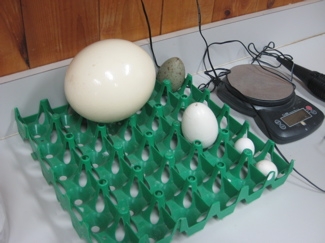 Really? You demand more from this blog? But it was so sunny and warm and fun! Sigh… Okay, okay, let’s break it down.
Really? You demand more from this blog? But it was so sunny and warm and fun! Sigh… Okay, okay, let’s break it down.
First of all, we didn’t really participate in the stuff mentioned above. We were very excited for the retrieving dog show, but I’ve gotta tell ya, it was really boring. (Of course, it was impressive and interesting to those interested in retrievers used as actual retrievers, but our problem was that Damian just wanted to run out there and hug the doggies. And that wasn’t going to fly too well, so we moved on rather quickly.)
We moved on back to the rearing barns which were really cool. It was sort of like your local petting zoo barn with goats and calves and stuff, but here each pen was occupied with cute little baby waterfowl. And again, there were many species I’d never heard of.
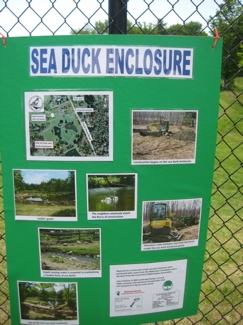 We spoke with an older gentleman in the rearing area who was an absolute expert on this stuff – as you’d expect. While Damian flitted about (“Duck” is one of his few words – and every bird that looks remotely like a “duh!” is, indeed without question, therefore a “duh!”), I spoke with the guy about the work the LRWC does and why they are important. I was shown an old incubator and some of the more modern equipment they use to raise the baby birds.
We spoke with an older gentleman in the rearing area who was an absolute expert on this stuff – as you’d expect. While Damian flitted about (“Duck” is one of his few words – and every bird that looks remotely like a “duh!” is, indeed without question, therefore a “duh!”), I spoke with the guy about the work the LRWC does and why they are important. I was shown an old incubator and some of the more modern equipment they use to raise the baby birds.
There was also a display of various eggs from various waterfowl and lots of informative signs and posters on the walls. And heck, it smelled a lot better than a typical barn with goats and pigs, that’s for sure.
Damian ran outside into the sunshine and headed over toward the Sharon Audubon exhibit area. They had brought along some of their captive raptors (who would, in a heartbeat, eat all those cute babies we just enjoyed ) which was really cool. They had a hawk and an eagle in cages, but one out on a pedestal. Many people were gathered around the ugly ol’ turkey vulture and Damian pushed his way through the forest of legs to get up front and center.
Just then, the imposing bird stretched its wings out to their full breadth in one startling swoop, sending everyone in proximity scurrying away with nervous giggles and gasps. Everyone, that is, except our Damian. He just laughed and laughed and signed for “more, more, more!”
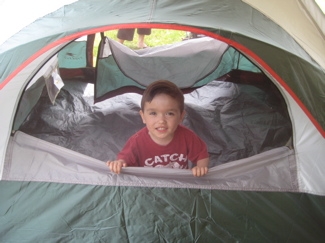 Sometimes I think I write CTMQ to have a repository for the Damian stories like this.
Sometimes I think I write CTMQ to have a repository for the Damian stories like this.
Damian led the way out and over to the vendor area, which was a fairly large collection of artists, artisans and organizations all interested in the outdoors and local wildlife. All the usual suspects were there: Watercooler artists, wood duck carvers, beekeepers, various conservation groups… All those guys. Everyone sort of milled about and I must say, I was very close to buying an LRWC tee shirt. They were only 10 bucks and rather attractive, featuring a Barrow’s goldeneye… I forget why I didn’t, but I didn’t.
The DEP and Ducks Unlimited were also there, as well as the White Memorial Foundation – an awesome area a few miles away with a museum and many miles of great hiking. They had brought along some skulls and a very large python. Damian, showing now fear, rather enjoyed both.
Once down with the vendors, we rumbled down the hill and over to the “real” aviary. The aviary is very large – several acres 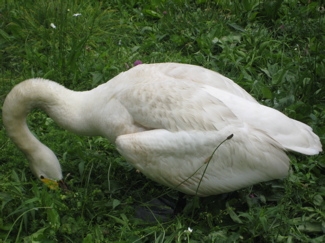 and contains a couple ponds, a walking trail and on Duck Day, a couple volunteer guides to assist in Identifying the birds.
and contains a couple ponds, a walking trail and on Duck Day, a couple volunteer guides to assist in Identifying the birds.
Some of the birds in this area are just stunningly beautiful. Sure, we’ve all seen blue herons and cranes before, but at LRWC, the’ve got all sorts of cool waterfowl.
I suggest you bring your binoculars if you go, as you can only get “so close” to the birds. I imagine having an official tour through here is really cool because in our situation, I had no idea what most of the birds we were looking at were. Oh well, it didn’t really diminish my enjoyment and I’m pretty sure Damian didn’t care.
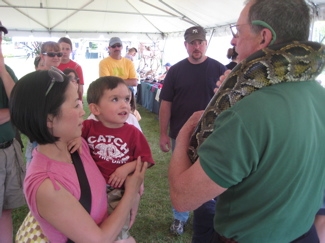 In fact, Damian doesn’t care about much – things like fences to keep people out are mere suggestions to the child as he was determined to get closer to the swans and herons. (In his defense, he was shorter than a lot of the fencing, so it wasn’t really “sneaking” to him so much as it was just walking towards the birds.) The volunteers shot us a couple annoyed looks and we knew it was time to move onward.
In fact, Damian doesn’t care about much – things like fences to keep people out are mere suggestions to the child as he was determined to get closer to the swans and herons. (In his defense, he was shorter than a lot of the fencing, so it wasn’t really “sneaking” to him so much as it was just walking towards the birds.) The volunteers shot us a couple annoyed looks and we knew it was time to move onward.
Back up the hill, back through the vendors, back towards the barns for one last look. It was at that point when we noticed some young women had a bunch of baby ducks (Mallards, I believe) and were allowing kids to pet them. Awww, who can deny a baby duck? Not I, not Hoang, not Damian. Enjoy… My photographic essay titled, “Beautiful Wife, Beautiful Boy, And a Baby Duck.”
As we slowly made our way toward the exit, I perused some of the literature I had picked up during our visit. The LRWC does a cool “Sea Duck Conservation Program” wherein you can “adopt a sea duck” in order to help conserve them. Sea ducks are a diverse group of waterfowl that are uniquely adapted to life at sea as well as on land. Sea ducks possess specialize bills for feeding in marine environments, from the strong heavy bills of the eiders which feed on mussels, to the long serrated bills of the mergansers that allow them to catch fish. They are masterful divers, with some species known to dive to depths of 180 feet.
A bunch of these guys are threatened or endangered, so this program seeks to help them out.
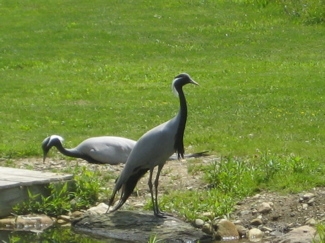 Another fun brochure I picked up is an attempt to spell out bird calls (It was from the Audubon Society, so it’s not just waterfowl). Some of them are written in onomatopoeia, but others are just words, which is sort of funny to me for some reason. For example, a plain old boring American robin apparently says, “Cheer Up! Cheerily! Cheer up! Cheerily!” And of course, a scarlet tanager sounds like a robin, but with a raspy, sore throat.
Another fun brochure I picked up is an attempt to spell out bird calls (It was from the Audubon Society, so it’s not just waterfowl). Some of them are written in onomatopoeia, but others are just words, which is sort of funny to me for some reason. For example, a plain old boring American robin apparently says, “Cheer Up! Cheerily! Cheer up! Cheerily!” And of course, a scarlet tanager sounds like a robin, but with a raspy, sore throat.
A cowbird says “Bubble bubble zee.” A chestnut-sided warbler croons, “pleased, pleased, pleased to meet ‘cha!” And then there’s the Black-throated blue Warbler – “beer beer beer breee!” I’ll be sure to invite this last guy to my next party.
All three of us really enjoyed our visit out to the Livingston Ripley Waterfowl Conservatory. Of course, I’d highly recommend visiting on Duck Day like we did (I assume it’s in early June every year), but I’m sure the quieter tour experience is equally as good – just different. There is an amazing array of birds from around the world, many of which casual bird fans like myself have never heard of. With all the stuff to do in Litchfield County, LRWC is sort of pushed to the side I think.
I also think they are perfectly fine with that.
“Witchity witchity witchity!”
— Common Yellowthroat
…………………………………………………….
Cost: Free to 10 bucks depending on when you go
Hours: tours on Sundays at 2:00 P.M. during tMay, June, Sept and Oct
Food & Drink?
Children? Look at those pictures again
You’ll like it if: Rhetorical
You won’t like it if: You are the spawn of Satan
Freebies: None
For the Curious:
Livingston Ripley Waterfowl Conservancy
Dillon Ripley’s Obit
Emperor Goose
Laysan Teal

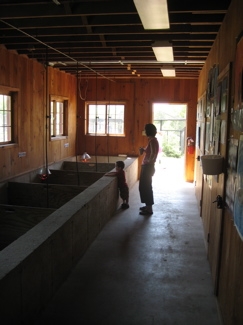
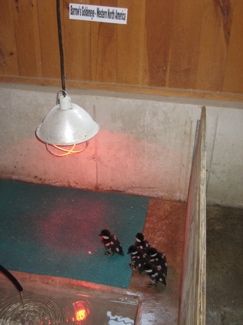
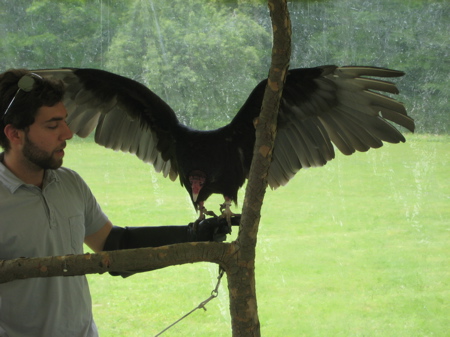
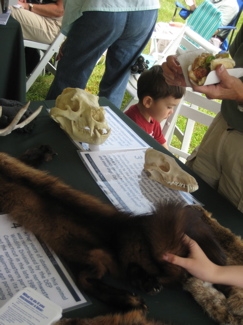

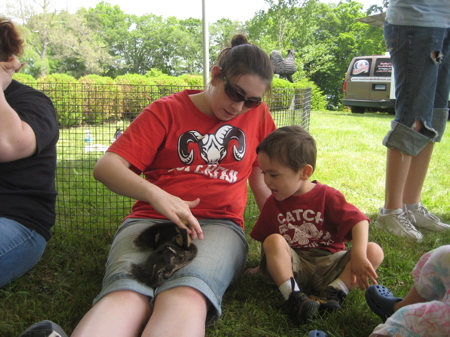
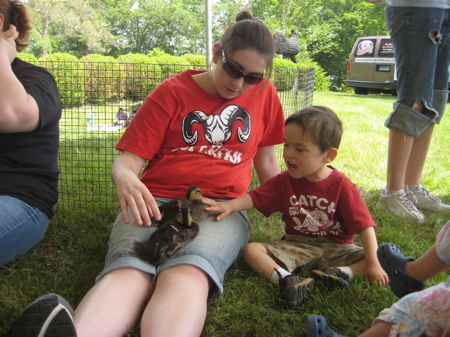
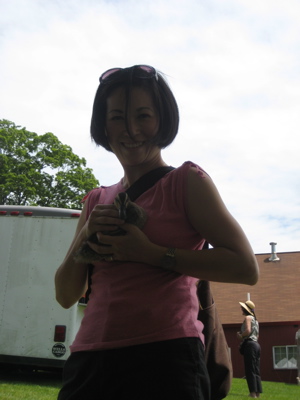
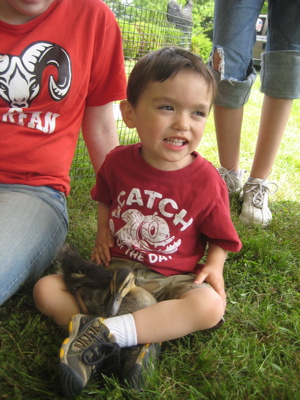
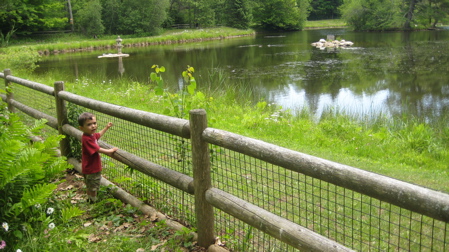






Do you need any volunteers? I am interested if you do.
Cathy Thiem
Comment #1 on 04.13.11 at 4:46 pmYou mean for literacy purposes?
Comment #2 on 02.12.13 at 8:24 pm